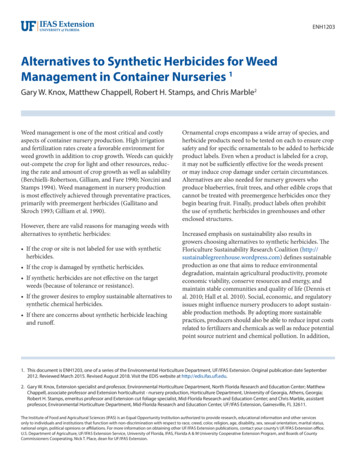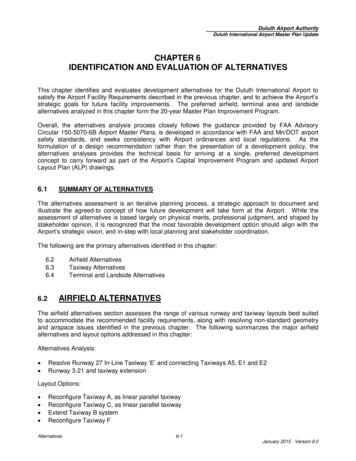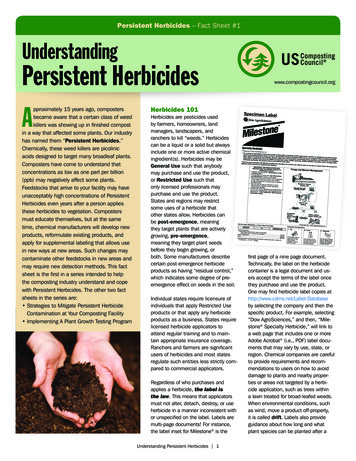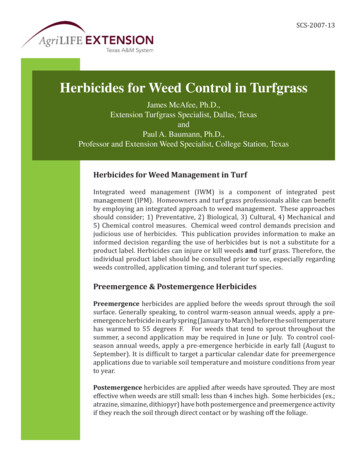
Transcription
ENH1203Alternatives to Synthetic Herbicides for WeedManagement in Container Nurseries 1Gary W. Knox, Matthew Chappell, Robert H. Stamps, and Chris Marble2Weed management is one of the most critical and costlyaspects of container nursery production. High irrigationand fertilization rates create a favorable environment forweed growth in addition to crop growth. Weeds can quicklyout-compete the crop for light and other resources, reducing the rate and amount of crop growth as well as salability(Berchielli-Robertson, Gilliam, and Fare 1990; Norcini andStamps 1994). Weed management in nursery productionis most effectively achieved through preventative practices,primarily with preemergent herbicides (Gallitano andSkroch 1993; Gilliam et al. 1990).However, there are valid reasons for managing weeds withalternatives to synthetic herbicides: If the crop or site is not labeled for use with syntheticherbicides. If the crop is damaged by synthetic herbicides. If synthetic herbicides are not effective on the targetweeds (because of tolerance or resistance). If the grower desires to employ sustainable alternatives tosynthetic chemical herbicides. If there are concerns about synthetic herbicide leachingand runoff.Ornamental crops encompass a wide array of species, andherbicide products need to be tested on each to ensure cropsafety and for specific ornamentals to be added to herbicideproduct labels. Even when a product is labeled for a crop,it may not be sufficiently effective for the weeds presentor may induce crop damage under certain circumstances.Alternatives are also needed for nursery growers whoproduce blueberries, fruit trees, and other edible crops thatcannot be treated with preemergence herbicides once theybegin bearing fruit. Finally, product labels often prohibitthe use of synthetic herbicides in greenhouses and otherenclosed structures.Increased emphasis on sustainability also results ingrowers choosing alternatives to synthetic herbicides. TheFloriculture Sustainability Research Coalition (http://sustainablegreenhouse.wordpress.com) defines sustainableproduction as one that aims to reduce environmentaldegradation, maintain agricultural productivity, promoteeconomic viability, conserve resources and energy, andmaintain stable communities and quality of life (Dennis etal. 2010; Hall et al. 2010). Social, economic, and regulatoryissues might influence nursery producers to adopt sustainable production methods. By adopting more sustainablepractices, producers should also be able to reduce input costsrelated to fertilizers and chemicals as well as reduce potentialpoint source nutrient and chemical pollution. In addition,1. This document is ENH1203, one of a series of the Environmental Horticulture Department, UF/IFAS Extension. Original publication date September2012. Reviewed March 2015. Revised August 2018. Visit the EDIS website at http://edis.ifas.ufl.edu.2. Gary W. Knox, Extension specialist and professor, Environmental Horticulture Department, North Florida Research and Education Center; MatthewChappell, associate professor and Extension horticulturist - nursery production, Horticulture Department, University of Georgia, Athens, Georgia;Robert H. Stamps, emeritus professor and Extension cut foliage specialist, Mid-Florida Research and Education Center; and Chris Marble, assistantprofessor, Environmental Horticulture Department, Mid-Florida Research and Education Center, UF/IFAS Extension, Gainesville, FL 32611.The Institute of Food and Agricultural Sciences (IFAS) is an Equal Opportunity Institution authorized to provide research, educational information and other servicesonly to individuals and institutions that function with non-discrimination with respect to race, creed, color, religion, age, disability, sex, sexual orientation, marital status,national origin, political opinions or affiliations. For more information on obtaining other UF/IFAS Extension publications, contact your county’s UF/IFAS Extension office.U.S. Department of Agriculture, UF/IFAS Extension Service, University of Florida, IFAS, Florida A & M University Cooperative Extension Program, and Boards of CountyCommissioners Cooperating. Nick T. Place, dean for UF/IFAS Extension.
sustainable production of nursery plants could foster thedevelopment of new specialty nurseries, creating a marketniche for “locally grown using sustainable methods.”Weed management alternatives to synthetic herbicidesinclude sanitation, exclusion, prevention, hand weeding,mulching, and the use of cover crops, heat, and nonsynthetic herbicides. Only some of these alternative methodscan be used to control weeds in containers, but all can beused to manage weeds around containers and in noncropareas. Also, most alternatives are not used alone becausethey cannot individually achieve weed control comparableto synthetic herbicides. Two or more alternatives are usuallyused simultaneously in order to achieve acceptable levels ofweed control.Sanitation–Exclusion–PreventionOne of the most effective and economical means of avoiding weed problems is preventing their presence throughexclusion and sanitation (Chappell, Williams-Woodward,and Knox 2012; Diver, Greer, and Adam 2008; Wilen 2010). Use containers, potting substrates, and fertilizers that donot contain weed seeds. Use weed-free plant/seed sources. Inspect all incomingliners for presence of weeds prior to potting. Use clean equipment. Manage a weed-free zone around and under containers. Manage weeds growing along the perimeter of thenursery and around a surface irrigation source.These practices prevent or reduce the number of weed seedsand other propagules (bulbs, corms, rhizomes, and stolons)that can grow and reproduce, compounding weed management efforts.The first critical step in reducing weed infestations is tofollow adequate sanitation measures during propagationand liner production. Liners are often the initial sourcefor introducing new weed species into production areas(Chappell, Williams-Woodward, and Knox 2012; Wilen2010). Few if any herbicides may be used in this phase ofproduction, necessitating reliance on sanitation and handweeding. When receiving liners from an outside source,it is critical to monitor containers for weed emergenceand to remove weeds before they reproduce and spread.If possible, visit liner and seed vendors to check out theirsanitation practices before doing business with them.Additionally, equipment, containers, substrates, and fertilizers used in production should not contain weed seeds orpropagules (Case, Mathers, and Senesac 2005; Chappell,Williams-Woodward, and Knox 2012; Wilen 2010). Simplywashing equipment and containers and covering substratestorage areas can significantly reduce weed pressure.Seeds are the primary source of weeds in productionenvironments (Wilen 2010). Considering that the immediate nursery environment is the source of most weeds (Crossand Skroch 1992), the elimination of seed-bearing weedswithin and adjacent to production areas can greatly reduceweed incidence and severity. This may entail working withneighboring property owners. Surface irrigation water alsomay be a source of weed seed if not sufficiently filteredbefore application (Kelley and Bruns 1975). To reduce weedintroduction via irrigation water, weeds from the peripheryof surface water supplies should be controlled prior to seedset. Irrigation intake pipes should be placed below the watersurface but high enough to avoid suction of sediment fromthe bottom of the water source. This is often accomplishedusing a floating dock system to suspend the intake pipe inthe water column.Hand WeedingRegardless of prevention efforts, wind, equipment, birds,and other animals (including humans) will eventuallyintroduce weeds (Wilen 2010). Nonchemical weed controlis done on a very limited basis in the nursery industry;however, it is critical to scout regularly for invading weedsand deal with them before they mature and spread. Handweeding is extremely labor intensive and thus an expensivecontrol option (Mathers 2003; Neal 2003). In addition, itmay be difficult to find laborers willing to work for wagestypical of the geographic area where the nursery is located,particularly near urban areas.Nonetheless, hand weeding is an integral part of anysuccessful weed control program since even preemergentherbicides are not 100% effective in eliminating weeds.Field nurseries practice mechanical cultivation, but typically as a supplement to an herbicide regime. Therefore,weed management should include regular scouting andhand weeding or mechanical control to prevent emergingweeds from maturing and dispersing seed. More frequenthand weeding will reduce overall hand weeding costs.Research has shown that weeding every 2 weeks versusevery 8 weeks can reduce hand weeding costs by an averageof 37% (Barker and Neal, 2016). Nurseries should strive tocreate a culture where “no weeds” is everyone’s mantra.Alternatives to Synthetic Herbicides for Weed Management in Container Nurseries2
MulchMulch is applied to the substrate surface to create a physicalbarrier that inhibits weed seed germination and suppressesweed growth (Ferguson, Rathinasabapathi, and Warren2008). Mulch is a traditional means of weed managementin field nurseries and landscapes and may be adapted tocontainer production (Billeaud and Zajicek 1989; Case,Mathers, and Senesac 2005).Two general types of mulch have been adapted to containerproduction: disk barriers and loose-fill products. Diskbarriers are permeable or impermeable products in theshape of a disk with a slit for placing the disk around astem and on the substrate surface. Disk barriers includeimpermeable, disk-shaped, solid plastic or cardboard lids,and permeable barriers composed of woven or particlebased products held together by resins or other binders(Chong 2003; Frangi et al. 2010; Mathers 2003) (Figure 1).Disk-type mulches are made from the following materials:Impermeable Solid plastic lid or bags CardboardPermeable Geotextile fabric Coconut fiber Hair PeatDisks can be useful for weed control, may reduce waterloss from container plants, and have been shown to neitherpositively nor negatively affect plant growth (Ruter 1997;1999).However, disks have issues of cost, handling, irrigation,and fertilization, as well as problems with fitting containersadequately to prevent weeds, especially with multistemplants or when two or three liners are planted into thesame pot (Chong 2003; Mathers 2003; Ruter 1999). If usingimpermeable disks, plants must be irrigated below thedisk via drip irrigation to maintain adequate soil moisture.Additionally, fertilizer must be placed under the disk tomaximize plant growth (Ruter 1999).Disks must be installed by hand, which increases laborcosts. Disks must fit the container exactly or there will begaps between the disk edge and container rim where weedsFigure 1. Permeable disk-type mulches composed of coconut fiber(upper left and lower right) and hair (upper right and lower left).Credits: James H. Aldrichcan grow (Figure 2). Even with exact container fit, there willbe gaps along the disk installation slit and around the plantstem where weeds can grow. In addition, the disk systemis limited to plants with a central leader because disks arenot designed to fit around multiple stems. Finally, somedisk products may be blown away or displaced by wind,resulting in exposed substrate where weeds can grow. Disksare usually removed before sale and often may be reusedseveral times; however, removing and reusing disks involvesadditional labor.Loose-fill mulches can be applied as a topdressing to thecontainer substrate (Case, Mathers, and Senesac 2005;Chong 2003; Cochran et al. 2009; Ferguson, Rathinasabapathi, and Warren 2008; Mathers 2003; Mervosh andAbbey 1999; Smith et al. 1997). Many loose-fill mulchesare locally available and inexpensive agricultural/forestryby-products. They include the following: Hulls and shells (almond, cocoa, hazelnut, pecan, peanut,rice, etc.) Starch/straw combination product Sawdust Wood chips Bark Chipped yard wasteAlternatives to Synthetic Herbicides for Weed Management in Container Nurseries3
Figure 3. Crumpled newspaper may be used as mulch.Credits: Gary W. KnoxFigure 2. Gaps between the disk edge and container rim, along theinstallation slit, and around the plant stem allow weeds to grow.Credits: Gary W. Knox Shredded tires Shredded, crumbled, or pelletized recycled newspaper(Figures 3 and 4)The ideal loose-fill mulch provides little or no nutrients,dries quickly after irrigation, resists decomposition, applies easily, and is cost effective, nontoxic to humans andcrops, readily available, and acceptable to customers. Fewproducts have many of these characteristics.Weed control efficacy of loose-fill mulches generallyincreases the deeper the mulch is applied (Cochran et al.2009; Penny and Neal 2003; Smith et al. 1997). Loose-fillmulch application may be mechanized (e.g., during potting)(Chong 2003). However, there are challenges associatedwith this option. Some mulches may contain weed seedsor phytotoxic components. Organic mulches may facilitateweed seedling development and may reduce availablenitrogen near the substrate surface if not composted(Billeaud and Zajicek 1989). Spillage during handling andproduction is an issue. Most loose-fill mulching systemsare considered more costly than an effective preemergenceherbicide program, but an economic comparison of suchsystems has not been reported.Living MulchMany field nursery crop producers use living mulchessuccessfully (Diver, Greer, and Adam 2008). They canbe adapted to container production, particularly withdeciduous crops in winter (Figure 5). These living mulchesFigure 4. Examples of pelletized and processed and colored recyclednewspaper that can be used as mulch.Credits: Robert H. Stampsor cover crops may be used as a seasonal groundcover thatsuppresses weeds without competing with crop production.Such systems must be customized to local conditions tofind the right combination of crop, living mulch species,and other compatible weed management practices.Other Alternative MethodsMost other nontraditional alternatives to synthetic herbicides are not adapted to managing weeds in containers butmay be applied around containers and in noncrop areas.For example, heat can be used to manage weeds in noncropareas (Mathers 2011). Heat acts to kill weeds by denaturingproteins in cell membranes and breaking down the cellularstructure of the weed. Alternatively, heat can induce waterwithin cells to boil, thereby exploding cells and desiccatingthe plant. Application equipment has been developed to apply heat via propane-generated flame, infrared emitters, anddirect application of boiling water or steam. Solarization, inwhich sunlight warms soil in a plastic-enclosed area, resultsin high temperatures that kill weeds, seeds, and disease andpest organisms (Stapleton, Wilen, and Molinar 2008).Alternatives to Synthetic Herbicides for Weed Management in Container Nurseries4
Salts, such as sodium chloride (table salt) (Mathers 2011)or ammonium chloride (Fausey 2003), can be used to killplants. They cause plant tissues to dehydrate via osmosis.Some combination products mix acetic acid, salt, citrusoil, eugenol, and other natural chemicals. A current list ofsynthetic and alternative postemergence herbicides labeledfor use in nurseries is available at http://edis.ifas.ufl.edu/wg059. Figure 5. Ryegrass seeded around a deciduous plant acts as a livingmulch in winter, dying in spring and serving as a mulch.Credits: Gary W. KnoxAlternatives to synthetic herbicides include naturalchemicals, such as acids, soaps, oils, and salts that can actas contact herbicides (Diver, Greer, and Adam 2008). Thesenonsynthetic herbicides are best used as a targeted sprayor in noncrop areas because contact can damage plants inproduction. It is important to note that these products donot kill roots, and repeated applications will be necessaryfor weeds that have the ability to regenerate from theirroots.For example, vinegar solutions can be sprayed to damageweeds (Diver, Greer, and Adam 2008; Fausey 2003).Vinegar is a product of fermentation containing about 5%acetic acid. It is more effective as a nonsynthetic herbicidewhen concentrated to levels of 15% and 30% acetic acidby distillation and freeze evaporation, respectively. Acidsolutions are believed to cause changes in plant cell pH thatresult in loss of cell membrane integrity and eventual death.Similarly, salts of fatty acids (soaps) act by penetrating cellsand disrupting cell membranes, ultimately causing desiccation and death (Diver, Greer, and Adam 2008). Soapsinclude pelargonic acid (Scythe ), ammonium nonanoate(Axxe ), and potassium salts of fatty acids.Plant-based oils, such as cinnamaldehyde (the primarycomponent of cinnamon), are used as contact herbicides(Diver, Greer, and Adam 2008; Fausey 2003). Oils arebelieved to disrupt cell membranes. Plant-based oils includeclove, eugenol, lemongrass, citrus, thyme, and oregano.Other alternative products include hydrogen dioxide(Fausey 2003) and plant by-products. Corn gluten meal,derived from processing corn, has not proven effective incontainers (Mervosh and Abbey 1999; Wilen, Schuch, andElmore 1999), particularly in high rainfall/irrigation areas.Mustard seed meal has shown promise for use with cropsgrown in the ground (Boydston et al. 2011; Handiseni etal. 2011) but has not been evaluated for use in containers.Finally, although there have been advances in biologicalcontrol of arthropod pests and plant pathogens in nurserycrops, no such strategies are currently available for weedcontrol in nurseries.ReferencesBarker, A. and J. C. Neal. 2016. “Frequent Hand Weeding Saves Money.” North Carolina State Extension.Accessed 13 Aug. 2018. -saves-moneyBerchielli-Robertson, D. L., C. H. Gilliam, and D. C. Fare.1990. “Competitive Effects of Weeds on the Growth ofContainer-Grown Plants.” HortScience 25(1): 77–79.Billeaud, L. A., and J. M. Zajicek. 1989. “Influence ofMulches on Weed Control, Soil pH, Soil Nitrogen Content,and Growth of Ligustrum japonicum.” J. Environ. Hort. 7(4):155–157.Boydston, R. A., M. J. Morra, V. Borek, L. Clayton, and S.F. Vaughn. 2011. “Onion and Weed Response to Mustard(Sinapis alba) Seed Meal.” Weed Sci. 59(4): 546–552.Case, L. T., H. M. Mathers, and A. F. Senesac. 2005. “AReview of Weed Control Practices in Container Nurseries.”HortTechnology 15(3): 535–545.Chappell, M. A., J. Williams-Woodward, and G. Knox.2012. Sanitation – A Key to Plant Health: From Start to Finish Part 2: Sanitation in General Production Areas. Athens:Georgia Cooperative Extension Service.Alternatives to Synthetic Herbicides for Weed Management in Container Nurseries5
Chong, C. 2003. “Experiences with Weed Discs and OtherNonchemical Alternatives for Container Weed Control.”HortTechnology 13(1): 23–27.Cochran, D. R., C. H. Gilliam, D. Eakes, G. R. Wehtje, P.R. Knight, and J. Olive. 2009. “Mulch Depth Affects WeedGermination.” J. Environ. Hort. 27(2): 85–90.Cross, G. B., and W. A. Skroch. 1992. “Quantification ofWeed Seed Contamination and Weed Development inContainer Nurseries.” J. Environ. Hort. 10(3): 159–161.Dennis, J. H., R. G. Lopez, B. K. Behe, C. R. Hall, C. Yue,and B. L. Campbell. 2010. “Sustainable Production PracticesAdopted by Greenhouse and Nursery Plant Growers.”HortScience 45 (8):1232–1237.Diver, S., L. Greer, and K. L. Adam. 2008. SustainableSmall-Scale Nursery Production. Butte, MT: ATTRA.Fausey, J. C. 2003. “Controlling Liverwort and Moss Nowand in the Future.” HortTechnology 13(1): 35–38.Ferguson, J., B. Rathinasabapathi, and C. Warren. 2008.“Southern Red Cedar and Southern Magnolia Wood ChipMulches for Weed Suppression in Containerized WoodyOrnamentals.” HortTechnology 18(2): 266–270.Frangi, P., R. Piatti, G. Amoroso, and A. Fini. 2010. “NonChemical Alternatives for Weed Control in ContainerizedPlants.” Acta Hort. 885: 119–122.Gallitano, L. B., and W. A. Skroch. 1993. “Herbicide Efficacyfor Production of Container Ornamentals.” Weed Tech. 7(1):103–111.Gilliam, C. H., W. J. Foster, J. L. Adrain, and R. L. Shumack.1990. “A Survey of Weed Control Costs and Strategies inContainer Production Nurseries.” J. Environ. Hort. 8(3):133–135.Hall, T. J., R. G. Lopez, M. I. Marshall, and J. H. Dennis.2010. “Barriers to Adopting Sustainable FloricultureCertification.” HortScience 45(5): 778–783.Handiseni, M., J. Brown, R. Zemetra, and M. Mazzola.2011. “Herbicidal Activity of Brassicaceae Seed Mealon Wild Oat (Avena fatua), Italian Ryegrass (Loliummultiflorum), Redroot Pigweed (Amaranthus retroflexus),and Prickly Lettuce (Lactuca serriola).” Weed Tech. 25(1):127–134.Kelley, A. D., and V. F. Bruns. 1975. “Dissemination ofWeed Seeds by Irrigation Water.” Weed Sci. 23(6): 486–493.Mathers, H. 2003. “Novel Methods of Weed Control inContainers.” HortTechnology 13(1): 28–34.Mathers, H. 2011. “Green vs. Greener: AlternativeOrnamental Weed Control.” Groundwork, May, 7–8, 10–13.http://www.lcamddcva.org/GW/d gw 0511.pdf.Mervosh, T. L., and T. M. Abbey. 1999. “Evaluation ofFabric Discs, Mulches and Herbicides for Preventing Weedsin Containers.” Proc. Northeastern Weed Sci. Soc. 1999: 122.Neal, J. 2003. “Understanding and Managing NurseryWeeds.” In Technical Nursery Papers, Issue 11. Epping:Nursery & Garden Industry Australia.Norcini, J. G., and R. H. Stamps. 1994. Container NurseryWeed Control. Circular 678. Gainesville: University ofFlorida Institute of Food and Agricultural Sciences.Penny, G. M., and J. C. Neal. 2003. “Light, Temperature,Seed Burial, and Mulch Effects on Mulberry Weed (Fatouavillosa) Seed Germination.” Weed Tech. 17(2): 213–218.Ruter, J. M. 1997. “Effects of Texel Geodiscs on Evaporationfrom #1 and #7 Containers.” Proc. Southern Nursery Assc.42: 420–422.Ruter, J. M. 1999. “Tex-R Geodiscs and Fertilizer PlacementInfluence Growth of ‘Compacta’ Holly.” Proc. SouthernNursery Assc. 44: 55–57.Smith, D., C. Gilliam, J. Edwards, D. Eakes, and J. Williams.1997. “Recycled Waste Paper as a Landscape Mulch.” J.Environ. Hort. 15(4): 191–196.Stapleton, J. J., C. A. Wilen, and R. H. Molinar. 2008. PestNotes: Soil Solarization for Gardens & Landscape Management. UC ANR Publication 74145. Davis: University ofCalifornia Statewide IPM Program.Wilen, C. A. 2010. UC IPM Pest Management Guidelines:Floriculture and Ornamental Nurseries: Weeds. Publication 3392. Davis: University of California Statewide IPMProgram.Wilen, C. A., U. K. Schuch, and C. L. Elmore. 1999.“Mulches and Subirrigation Control Weeds in ContainerProduction.” J. Environ. Hort. 17(4): 174–180.Alternatives to Synthetic Herbicides for Weed Management in Container Nurseries6
Management in Container Nurseries 1 Gary W. Knox, Matthew Chappell, Robert H. Stamps, and Chris Marble2 1. This document is ENH1203, one of a series of the Environmental Horticulture Department, UF/IFAS Extension. Original publication date September . Alternatives to Synthetic Herbicides for Weed Management in Container Nurseries 2










